+ データを開く
データを開く
- 基本情報
基本情報
| 登録情報 |  | |||||||||
|---|---|---|---|---|---|---|---|---|---|---|
| タイトル | Structure of human UBR4-KCMF1-CaM E3 ligase complex (Silencing Factor of the Integrated stress response, SiFI) | |||||||||
 マップデータ マップデータ | ||||||||||
 試料 試料 |
| |||||||||
 キーワード キーワード | E3 liase / UBR4 / SIFI / LIGASE | |||||||||
| 機能・相同性 |  機能・相同性情報 機能・相同性情報negative regulation of HRI-mediated signaling / synaptic signaling / ubiquitin-dependent protein catabolic process via the N-end rule pathway / protein K27-linked ubiquitination / cytoplasm protein quality control by the ubiquitin-proteasome system / protein branched polyubiquitination / negative regulation of fatty acid biosynthetic process / endosome organization / cytoplasm protein quality control / protein K11-linked ubiquitination ...negative regulation of HRI-mediated signaling / synaptic signaling / ubiquitin-dependent protein catabolic process via the N-end rule pathway / protein K27-linked ubiquitination / cytoplasm protein quality control by the ubiquitin-proteasome system / protein branched polyubiquitination / negative regulation of fatty acid biosynthetic process / endosome organization / cytoplasm protein quality control / protein K11-linked ubiquitination / CaM pathway / Cam-PDE 1 activation / Sodium/Calcium exchangers / Calmodulin induced events / positive regulation of ryanodine-sensitive calcium-release channel activity / Reduction of cytosolic Ca++ levels / Activation of Ca-permeable Kainate Receptor / CREB1 phosphorylation through the activation of CaMKII/CaMKK/CaMKIV cascasde / Loss of phosphorylation of MECP2 at T308 / CREB1 phosphorylation through the activation of Adenylate Cyclase / CaMK IV-mediated phosphorylation of CREB / PKA activation / negative regulation of high voltage-gated calcium channel activity / Glycogen breakdown (glycogenolysis) / CLEC7A (Dectin-1) induces NFAT activation / Activation of RAC1 downstream of NMDARs / organelle localization by membrane tethering / negative regulation of ryanodine-sensitive calcium-release channel activity / mitochondrion-endoplasmic reticulum membrane tethering / autophagosome membrane docking / negative regulation of calcium ion export across plasma membrane / regulation of cardiac muscle cell action potential / presynaptic endocytosis / Synthesis of IP3 and IP4 in the cytosol / regulation of cell communication by electrical coupling involved in cardiac conduction / Phase 0 - rapid depolarisation / calcineurin-mediated signaling / Negative regulation of NMDA receptor-mediated neuronal transmission / Unblocking of NMDA receptors, glutamate binding and activation / RHO GTPases activate PAKs / Ion transport by P-type ATPases / Uptake and function of anthrax toxins / regulation of ryanodine-sensitive calcium-release channel activity / tertiary granule membrane / ficolin-1-rich granule membrane / Long-term potentiation / protein phosphatase activator activity / Calcineurin activates NFAT / Regulation of MECP2 expression and activity / DARPP-32 events / protein K63-linked ubiquitination / catalytic complex / Smooth Muscle Contraction / detection of calcium ion / regulation of cardiac muscle contraction / RHO GTPases activate IQGAPs / regulation of cardiac muscle contraction by regulation of the release of sequestered calcium ion / protein K48-linked ubiquitination / calcium channel inhibitor activity / specific granule membrane / cellular response to interferon-beta / presynaptic cytosol / Protein methylation / Activation of AMPK downstream of NMDARs / Ion homeostasis / regulation of release of sequestered calcium ion into cytosol by sarcoplasmic reticulum / eNOS activation / titin binding / Tetrahydrobiopterin (BH4) synthesis, recycling, salvage and regulation / sperm midpiece / voltage-gated potassium channel complex / regulation of calcium-mediated signaling / calcium channel complex / positive regulation of autophagy / substantia nigra development / FCERI mediated Ca+2 mobilization / Ras activation upon Ca2+ influx through NMDA receptor / regulation of heart rate / FCGR3A-mediated IL10 synthesis / adenylate cyclase activator activity / calyx of Held / Antigen activates B Cell Receptor (BCR) leading to generation of second messengers / protein serine/threonine kinase activator activity / VEGFR2 mediated cell proliferation / sarcomere / regulation of cytokinesis / VEGFR2 mediated vascular permeability / Translocation of SLC2A4 (GLUT4) to the plasma membrane / spindle microtubule / positive regulation of receptor signaling pathway via JAK-STAT / RAF activation / Transcriptional activation of mitochondrial biogenesis / RING-type E3 ubiquitin transferase / Stimuli-sensing channels / cellular response to type II interferon / long-term synaptic potentiation / response to calcium ion / RAS processing / spindle pole / Signaling by RAF1 mutants 類似検索 - 分子機能 | |||||||||
| 生物種 |  Homo sapiens (ヒト) Homo sapiens (ヒト) | |||||||||
| 手法 | 単粒子再構成法 / クライオ電子顕微鏡法 / 解像度: 3.4 Å | |||||||||
 データ登録者 データ登録者 | Yang Z / Rape M | |||||||||
| 資金援助 |  米国, 2件 米国, 2件
| |||||||||
 引用 引用 |  ジャーナル: Nature / 年: 2025 ジャーナル: Nature / 年: 2025タイトル: Molecular basis of SIFI activity in the integrated stress response. 著者: Zhi Yang / Diane L Haakonsen / Michael Heider / Samuel R Witus / Alex Zelter / Tobias Beschauner / Michael J MacCoss / Michael Rapé /    要旨: Chronic stress response activation impairs cell survival and causes devastating degenerative diseases. Organisms accordingly deploy silencing factors, such as the E3 ubiquitin ligase silencing factor ...Chronic stress response activation impairs cell survival and causes devastating degenerative diseases. Organisms accordingly deploy silencing factors, such as the E3 ubiquitin ligase silencing factor of the integrated stress response (SIFI), to terminate stress response signalling and ensure cellular homeostasis. How a silencing factor can sense stress across cellular scales to elicit timely stress response inactivation is poorly understood. Here we combine cryo-electron microscopy analysis of endogenous SIFI with AlphaFold modelling and biochemical studies to report the structural and mechanistic basis of the silencing of the integrated stress response. SIFI detects both stress indicators and stress response components through flexible domains within an easily accessible scaffold, before building linkage-specific ubiquitin chains at separate, sterically restricted elongation modules. Ubiquitin handover by a ubiquitin-like domain couples versatile substrate modification to linkage-specific ubiquitin polymer formation. Stress response silencing therefore exploits a catalytic mechanism that is geared towards processing many diverse proteins and therefore allows a single enzyme to monitor and, if needed, modulate a complex cellular state. | |||||||||
| 履歴 |
|
- 構造の表示
構造の表示
| 添付画像 |
|---|
- ダウンロードとリンク
ダウンロードとリンク
-EMDBアーカイブ
| マップデータ |  emd_46686.map.gz emd_46686.map.gz | 267.1 MB |  EMDBマップデータ形式 EMDBマップデータ形式 | |
|---|---|---|---|---|
| ヘッダ (付随情報) |  emd-46686-v30.xml emd-46686-v30.xml emd-46686.xml emd-46686.xml | 26.8 KB 26.8 KB | 表示 表示 |  EMDBヘッダ EMDBヘッダ |
| FSC (解像度算出) |  emd_46686_fsc.xml emd_46686_fsc.xml | 19.1 KB | 表示 |  FSCデータファイル FSCデータファイル |
| 画像 |  emd_46686.png emd_46686.png | 94.1 KB | ||
| マスクデータ |  emd_46686_msk_1.map emd_46686_msk_1.map | 282.6 MB |  マスクマップ マスクマップ | |
| Filedesc metadata |  emd-46686.cif.gz emd-46686.cif.gz | 9.8 KB | ||
| その他 |  emd_46686_additional_1.map.gz emd_46686_additional_1.map.gz emd_46686_half_map_1.map.gz emd_46686_half_map_1.map.gz emd_46686_half_map_2.map.gz emd_46686_half_map_2.map.gz | 266.4 MB 262.4 MB 262.4 MB | ||
| アーカイブディレクトリ |  http://ftp.pdbj.org/pub/emdb/structures/EMD-46686 http://ftp.pdbj.org/pub/emdb/structures/EMD-46686 ftp://ftp.pdbj.org/pub/emdb/structures/EMD-46686 ftp://ftp.pdbj.org/pub/emdb/structures/EMD-46686 | HTTPS FTP |
-検証レポート
| 文書・要旨 |  emd_46686_validation.pdf.gz emd_46686_validation.pdf.gz | 993.6 KB | 表示 |  EMDB検証レポート EMDB検証レポート |
|---|---|---|---|---|
| 文書・詳細版 |  emd_46686_full_validation.pdf.gz emd_46686_full_validation.pdf.gz | 993.2 KB | 表示 | |
| XML形式データ |  emd_46686_validation.xml.gz emd_46686_validation.xml.gz | 22.3 KB | 表示 | |
| CIF形式データ |  emd_46686_validation.cif.gz emd_46686_validation.cif.gz | 29.7 KB | 表示 | |
| アーカイブディレクトリ |  https://ftp.pdbj.org/pub/emdb/validation_reports/EMD-46686 https://ftp.pdbj.org/pub/emdb/validation_reports/EMD-46686 ftp://ftp.pdbj.org/pub/emdb/validation_reports/EMD-46686 ftp://ftp.pdbj.org/pub/emdb/validation_reports/EMD-46686 | HTTPS FTP |
-関連構造データ
| 関連構造データ |  9d9zMC  9nwdC  9nweC C: 同じ文献を引用 ( M: このマップから作成された原子モデル |
|---|---|
| 類似構造データ | 類似検索 - 機能・相同性  F&H 検索 F&H 検索 |
- リンク
リンク
| EMDBのページ |  EMDB (EBI/PDBe) / EMDB (EBI/PDBe) /  EMDataResource EMDataResource |
|---|---|
| 「今月の分子」の関連する項目 |
- マップ
マップ
| ファイル |  ダウンロード / ファイル: emd_46686.map.gz / 形式: CCP4 / 大きさ: 282.6 MB / タイプ: IMAGE STORED AS FLOATING POINT NUMBER (4 BYTES) ダウンロード / ファイル: emd_46686.map.gz / 形式: CCP4 / 大きさ: 282.6 MB / タイプ: IMAGE STORED AS FLOATING POINT NUMBER (4 BYTES) | ||||||||||||||||||||||||||||||||||||
|---|---|---|---|---|---|---|---|---|---|---|---|---|---|---|---|---|---|---|---|---|---|---|---|---|---|---|---|---|---|---|---|---|---|---|---|---|---|
| 投影像・断面図 | 画像のコントロール
画像は Spider により作成 | ||||||||||||||||||||||||||||||||||||
| ボクセルのサイズ | X=Y=Z: 1.048 Å | ||||||||||||||||||||||||||||||||||||
| 密度 |
| ||||||||||||||||||||||||||||||||||||
| 対称性 | 空間群: 1 | ||||||||||||||||||||||||||||||||||||
| 詳細 | EMDB XML:
|
-添付データ
-マスク #1
| ファイル |  emd_46686_msk_1.map emd_46686_msk_1.map | ||||||||||||
|---|---|---|---|---|---|---|---|---|---|---|---|---|---|
| 投影像・断面図 |
| ||||||||||||
| 密度ヒストグラム |
-追加マップ: Gaussian filtered map with width sdev=1.6 to see...
| ファイル | emd_46686_additional_1.map | ||||||||||||
|---|---|---|---|---|---|---|---|---|---|---|---|---|---|
| 注釈 | Gaussian filtered map with width sdev=1.6 to see better density of the KCMF1n-DOC1-UBR region. | ||||||||||||
| 投影像・断面図 |
| ||||||||||||
| 密度ヒストグラム |
-ハーフマップ: #2
| ファイル | emd_46686_half_map_1.map | ||||||||||||
|---|---|---|---|---|---|---|---|---|---|---|---|---|---|
| 投影像・断面図 |
| ||||||||||||
| 密度ヒストグラム |
-ハーフマップ: #1
| ファイル | emd_46686_half_map_2.map | ||||||||||||
|---|---|---|---|---|---|---|---|---|---|---|---|---|---|
| 投影像・断面図 |
| ||||||||||||
| 密度ヒストグラム |
- 試料の構成要素
試料の構成要素
-全体 : Endogenous UBR4-KCMF1-CaM E3 Ligase complex (Silencing Factor of ...
| 全体 | 名称: Endogenous UBR4-KCMF1-CaM E3 Ligase complex (Silencing Factor of the Integrated stress response) |
|---|---|
| 要素 |
|
-超分子 #1: Endogenous UBR4-KCMF1-CaM E3 Ligase complex (Silencing Factor of ...
| 超分子 | 名称: Endogenous UBR4-KCMF1-CaM E3 Ligase complex (Silencing Factor of the Integrated stress response) タイプ: complex / ID: 1 / 親要素: 0 / 含まれる分子: #1-#3 |
|---|---|
| 由来(天然) | 生物種:  Homo sapiens (ヒト) Homo sapiens (ヒト) |
| 分子量 | 理論値: 1.3 MDa |
-分子 #1: UBR4 (endogenously FLAG-tagged at the N-terminus),E3 ubiquitin-pr...
| 分子 | 名称: UBR4 (endogenously FLAG-tagged at the N-terminus),E3 ubiquitin-protein ligase UBR4,E3 ubiquitin-protein ligase UBR4,E3 ubiquitin-protein ligase UBR4 タイプ: protein_or_peptide / ID: 1 / 詳細: (endogenously FLAG-tagged at the N-terminus) / コピー数: 2 / 光学異性体: LEVO / EC番号: RING-type E3 ubiquitin transferase |
|---|---|
| 由来(天然) | 生物種:  Homo sapiens (ヒト) Homo sapiens (ヒト) |
| 分子量 | 理論値: 577.180938 KDa |
| 配列 | 文字列: MDYKDHDGDY KDHDIDYKDD DDKATSGGEE AAAAAPAPGT PATGADTTPG WEVAVRPLLS ASYSAFEMKE LPQLVASVIE SESEILHHE KQYEPFYSSF VALSTHYITT VCSLIPRNQL QSVAAACKVL IEFSLLRLEN PDEACAVSQK HLILLIKGLC T GCSRLDRT ...文字列: MDYKDHDGDY KDHDIDYKDD DDKATSGGEE AAAAAPAPGT PATGADTTPG WEVAVRPLLS ASYSAFEMKE LPQLVASVIE SESEILHHE KQYEPFYSSF VALSTHYITT VCSLIPRNQL QSVAAACKVL IEFSLLRLEN PDEACAVSQK HLILLIKGLC T GCSRLDRT EIITFTAMMK SAKLPQTVKT LSDVEDQKEL ASPVSPELRQ KEVQMNFLNQ LTSVFNPRTV ASQPISTQTL VE GENDEQS STDQASAIKT KNVFIAQNVA SLQELGGSEK LLRVCLNLPY FLRYINRFQD AVLANSFFIM PATVADATAV RNG FHSLVI DVTMALDTLS LPVLEPLNPS RLQDVTVLSL SCLYAGVSVA TCMAILHVGS AQQVRTGSTS SKEDDYESDA ATIV QKCLE IYDMIGQAIS SSRRAGGEHY QNFQLLGAWC LLNSLFLILN LSPTALADKG KEKDPLAALR VRDILSRTKE GVGSP KLGP GKGHQGFGVL SVILANHAIK LLTSLFQDLQ VEALHKGWET DGPPAALSIM AQSTSIQRIQ RLIDSVPLMN LLLTLL STS YRKACVLQRQ RKGSMSSDAS ASTDSNTYYE DDFSSTEEDS SQDDDSEPIL GQWFEETISP SKEKAAPPPP PPPPPLE SS PRVKSPSKQA PGEKGNILAS RKDPELFLGL ASNILNFITS SMLNSRNNFI RNYLSVSLSE HHMATLASII KEVDKDGL K GSSDEEFAAA LYHFNHSLVT SDLQSPNLQN TLLQQLGVAP FSEGPWPLYI HPQSLSVLSR LLLIWQHKAS AQGDPDVPE CLKVWDRFLS TMKQNALQGV VPSETEDLNV EHLQMLLLIF HNFTETGRRA ILSLFVQIIQ ELSVNMDAQM RFVPLILARL LLIFDYLLH QYSKAPVYLF EQVQHNLLSP PFGWASGSQD SNSRRATTPL YHGFKEVEEN WSKHFSSDAV PHPRFYCVLS P EASEDDLN RLDSVACDVL FSKLVKYDEL YAALTALLAA GSQLDTVRRK ENKNVTALEA CALQYYFLIL WRILGILPPS KT YINQLSM NSPEMSECDI LHTLRWSSRL RISSYVNWIK DHLIKQGMKA EHASSLLELA STTKCSSVKY DVEIVEEYFA RQI SSFCSI DCTTILQLHE IPSLQSIYTL DAAISKVQVS LDEHFSKMAA ETDPHKSSEI TKNLLPATLQ LIDTYASFTR AYLL QNFNE EGTTEKPSKE KLQGFAAVLA IGSSRCKANT LGPTLVQNLP SSVQTVCESW NNINTNEFPN IGSWRNAFAN DTIPS ESYI SAVQAAHLGT LCSQSLPLAA SLKHTLLSLV RLTGDLIVWS DEMNPPQVIR TLLPLLLESS TESVAEISSN SLERIL GPA ESDEFLARVY EKLITGCYNI LANHADPNSG LDESILEECL QYLEKQLESS QARKAMEEFF SDSGELVQIM MATANEN LS AKFCNRVLKF FTKLFQLTEK SPNPSLLHLC GSLAQLACVE PVRLQAWLTR MTTSPPKDSD QLDVIQENRQ LLQLLTTY I VRENSQVGEG VCAVLLGTLT PMATEMLANG DGTGFPELMV VMATLASAGQ GAGHLQLHNA AVDWLSRCKK YLSQKNVVE KLNANVMHGK HVMILECTCH IMSYLADVTN ALSQSNGQGP SHLSVDGEER AIEVDSDWVE ELAVEEEDSQ AEDSDEDSLC NKLCTFTIT QKEFMNQHWY HCHTCKMVDG VGVCTVCAKV CHKDHEISYA KYGSFFCDCG AKEDGSCLAL VKRTPSSGMS S TMKESAFQ SEPRISESLV RHASTSSPAD KAKVTISDGK VADEEKPKKS SLCRTVEGCR EELQNQANFS FAPLVLDMLN FL MDAIQTN FQQASAVGSS SRAQQALSEL HTVEKAVEMT DQLMVPTLGS QEGAFENVRM NYSGDQGQTI RQLISAHVLR RVA MCVLSS PHGRRQHLAV SHEKGKITVL QLSALLKQAD SSKRKLTLTR LASAPVPFTV LSLTGNPCKE DYLAVCGLKD CHVL TFSSS GSVSDHLVLH PQLATGNFII KAVWLPGSQT ELAIVTADFV KIYDLCVDAL SPTFYFLLPS SKIRDVTFLF NEEGK NIIV IMSSAGYIYT QLMEEASSAQ QGPFYVTNVL EINHEDLKDS NSQVAGGGVS VYYSHVLQML FFSYCQGKSF AATISR TTL EVLQLFPINI KSSNGGSKTS PALCQWSEVM NHPGLVCCVQ QTTGVPLVVM VKPDTFLIQE IKTLPAKAKI QDMVAIR HT ACNEQQRTTM ILLCEDGSLR IYMANVENTS YWLQPSLQPS SVISIMKPVR KRKTATITTR TSSQVTFPID FFEHNQQL T DVEFGGNDLL QVYNAQQIKH RLNSTGMYVA NTKPGGFTIE ISNNNSTMVM TGMRIQIGTQ AIERAPSYIE IFGRTMQLN LSRSRWFDFP FTREEALQAD KKLNLFIGAS VDPAGVTMID AVKIYGKTKE QFGWPDEPPE EFPSASVSNI CPSNLNQSNG TGDSDSAAP TTTSGTVLER LVVSSLEALE SCFAVGPIIE KERNKNAAQE LATLLLSLPA PASVQQQSKS LLASLHTSRS A YHSHKDQA LLSKAVQCLN TSSKEGKDLD PEVFQRLVIT ARSIAIMRPN NLVHFTESKL PQMETEGMDE GKEPQKQLEG DC CSFITQL VNHFWKLHAS KPKNAFLAPA CLPGLTHIEA TVNALVDIIH GYCTCELDCI NTASKIYMQM LLCPDPAVSF SCK QALIRV LRPRNKRRHV TLPSSPRSNT PMGDKDDDDD DDADEKMQSS GIPNGGHIRQ ESQEQSEVDH GDFEMVSESM VLET AENVN NGNPSPLEAL LAGAEGFPPM LDIPPDADDE TMVELAIALS LQQDQQGSSS SALGLQSLGL SGQAPSSSSL DAGTL SDTT ASAPASDDEG STAATDGSTL RTSPADHGGS VGSESGGSAV DSVAGEHSVS GRSSAYGDAT AEGHPAGPGS VSSSTG AIS TTTGHQEGDG SEGEGEGETE GDVHTSNRLH MVRLMLLERL LQTLPQLRNV GGVRAIPYMQ VILMLTTDLD GEDEKDK GA LDNLLSQLIA ELGMDKKDVS KKNERSALNE VHLVVMRLLS VFMSRTKSGS KSSICESSSL ISSATAAALL SSGAVDYC L HVLKSLLEYW KSQQNDEEPV ATSQLLKPHT TSSPPDMSPF FLRQYVKGHA ADVFEAYTQL LTEMVLRLPY QIKKITDTN SRIPPPVFDH SWFYFLSEYL MIQQTPFVRR QVRKLLLFIC GSKEKYRQLR DLHTLDSHVR GIKKLLEEQG IFLRASVVTA SSGSALQYD TLISLMEHLK ACAEIAAQRT INWQKFCIKD DSVLYFLLQV SFLVDEGVSP VLLQLLSCAL CGSKVLAALA A SSGSSSAS SSSAPVAASS GQATTQSKSS TKKSKKEEKE KEKDGETSGS QEDQLCTALV NQLNKFADKE TLIQFLRCFL LE SNSSSVR WQAHCLTLHI YRNSSKSQQE LLLDLMWSIW PELPAYGRKA AQFVDLLGYF SLKTPQTEKK LKEYSQKAVE ILR TQNHIL TNHPNSNIYN TLSGLVEFDG YYLESDPCLV CNNPEVPFCY IKLSSIKVDT RYTTTQQVVK LIGSHTISKV TVKI GDLKR TKMVRTINLY YNNRTVQAIV ELKNKPARWH KAKKVQLTPG QTEVKIDLPL PIVASNLMIE FADFYENYQA STETL QCPR CSASVPANPG VCGNCGENVY QCHKCRSINY DEKDPFLCNA CGFCKYARFD FMLYAKPCCA VDPIENEEDR KKAVSN INT LLDKADRVYH QLMGHRPQLE NLLCKVNEAA PEKPQDDSGT AGGISSTSAS VNRYILQLAQ EYCGDCKNSF DELSKII QK VFASRKELLE YDLQQREAAT KSSRTSVQPT FTASQYRALS VLGCGHTSST KCYGCASAVT EHCITLLRAL ATNPALRH I LVSQGLIREL FDYNLRRGAA AMREEVRQLM CLLTRDNPEA TQQMNDLIIG KVSTALKGHW ANPDLASSLQ YEMLLLTDS ISKEDSCWEL RLRCALSLFL MAVNIKTPVV VENITLMCLR ILQKLIKPPA PTSKKNKDVP VEALTTVKPY CNEIHAQAQL WLKRDPKAS YDAWKKCLPI RGIDGNGKAP SKSELRHLYL TEKYVWRWKQ FLSRRGKRTS PLDLKLGHNN WLRQVLFTPA T QAARQAAC TIVEALATIP SRKQQVLDLL TSYLDELSIA GECAAEYLAL YQKLITSAHW KVYLAARGVL PYVGNLITKE IA RLLALEE ATLSTDLQQG YALKSLTGLL SSFVEVESIK RHFKSRLVGT VLNGYLCLRK LVVQRTKLID ETQDMLLEML EDM TTGTES ETKAFMAVCI ETAKRYNLDD YRTPVFIFER LCSIIYPEEN EVTEFFVTLE KDPQQEDFLQ GRMPGNPYSS NEPG IGPLM RDIKNKICQD CDLVALLEDD SGMELLVNNK IISLDLPVAE VYKKVWCTTN EGEPMRIVYR MRGLLGDATE EFIES LDST TDEEEDEEEV YKMAGVMAQC GGLECMLNRL AGIRDFKQGR HLLTVLLKLF SYCVKVKVNR QQLVKLEMNT LNVMLG TLN LALVAEQESK DSGGAAVAEQ VLSIMEIILD ESNAEPLSED KGNLLLTGDK DQLVMLLDQI NSTFVRSNPS VLQGLLR II PYLSFGEVEK MQILVERFKP YCNFDKYDED HSGDDKVFLD CFCKIAAGIK NNSNGHQLKD LILQKGITQN ALDYMKKH I PSAKNLDADI WKKFLSRPAL PFILRLLRGL AIQHPGTQVL IGTDSIPNLH KLEQVSSDEG IGTLAENLLE ALREHPDVN KKIDAARRET RAEKKRMAMA MRQKALGTLG MTTNEKGQVV TKTALLKQME ELIEEPGLTC CICREGYKFQ PTKVLGIYTF TKRVALEEM ENKPRKQQGY STVSHFNIVH YDCHLAAVRL ARGREEWESA ALQNANTKCN GLLPVWGPHV PESAFATCLA R HNTYLQEC TGQREPTYQL NIHDIKLLFL RFAMEQSFSA DTGGGGRESN IHLIPYIIHT VLYVLNTTRA TSREEKNLQG FL EQPKEKW VESAFEVDGP YYFTVLALHI LPPEQWRATR VEILRRLLVT SQARAVAPGG ATRLTDKAVK DYSAYRSSLL FWA LVDLIY NMFKKVPTSN TEGGWSCSLA EYIRHNDMPI YEAADKALKT FQEEFMPVET FSEFLDVAGL LSEITDPESF LKDL LNSVP UniProtKB: E3 ubiquitin-protein ligase UBR4 |
-分子 #2: Calmodulin-1
| 分子 | 名称: Calmodulin-1 / タイプ: protein_or_peptide / ID: 2 / コピー数: 2 / 光学異性体: LEVO |
|---|---|
| 由来(天然) | 生物種:  Homo sapiens (ヒト) Homo sapiens (ヒト) |
| 分子量 | 理論値: 16.852545 KDa |
| 配列 | 文字列: MADQLTEEQI AEFKEAFSLF DKDGDGTITT KELGTVMRSL GQNPTEAELQ DMINEVDADG NGTIDFPEFL TMMARKMKDT DSEEEIREA FRVFDKDGNG YISAAELRHV MTNLGEKLTD EEVDEMIREA DIDGDGQVNY EEFVQMMTAK UniProtKB: Calmodulin-1 |
-分子 #3: E3 ubiquitin-protein ligase KCMF1
| 分子 | 名称: E3 ubiquitin-protein ligase KCMF1 / タイプ: protein_or_peptide / ID: 3 / コピー数: 2 / 光学異性体: LEVO / EC番号: RING-type E3 ubiquitin transferase |
|---|---|
| 由来(天然) | 生物種:  Homo sapiens (ヒト) Homo sapiens (ヒト) |
| 分子量 | 理論値: 41.992348 KDa |
| 配列 | 文字列: MSRHEGVSCD ACLKGNFRGR RYKCLICYDY DLCASCYESG ATTTRHTTDH PMQCILTRVD FDLYYGGEAF SVEQPQSFTC PYCGKMGYT ETSLQEHVTS EHAETSTEVI CPICAALPGG DPNHVTDDFA AHLTLEHRAP RDLDESSGVR HVRRMFHPGR G LGGPRARR ...文字列: MSRHEGVSCD ACLKGNFRGR RYKCLICYDY DLCASCYESG ATTTRHTTDH PMQCILTRVD FDLYYGGEAF SVEQPQSFTC PYCGKMGYT ETSLQEHVTS EHAETSTEVI CPICAALPGG DPNHVTDDFA AHLTLEHRAP RDLDESSGVR HVRRMFHPGR G LGGPRARR SNMHFTSSST GGLSSSQSSY SPSNREAMDP IAELLSQLSG VRRSAGGQLN SSGPSASQLQ QLQMQLQLER QH AQAARQQ LETARNATRR TNTSSVTTTI TQSTATTNIA NTESSQQTLQ NSQFLLTRLN DPKMSETERQ SMESERADRS LFV QELLLS TLVREESSSS DEDDRGEMAD FGAMGCVDIM PLDVALENLN LKESNKGNEP PPPPL UniProtKB: E3 ubiquitin-protein ligase KCMF1 |
-分子 #4: ZINC ION
| 分子 | 名称: ZINC ION / タイプ: ligand / ID: 4 / コピー数: 20 / 式: ZN |
|---|---|
| 分子量 | 理論値: 65.409 Da |
-分子 #5: CALCIUM ION
| 分子 | 名称: CALCIUM ION / タイプ: ligand / ID: 5 / コピー数: 4 / 式: CA |
|---|---|
| 分子量 | 理論値: 40.078 Da |
-実験情報
-構造解析
| 手法 | クライオ電子顕微鏡法 |
|---|---|
 解析 解析 | 単粒子再構成法 |
| 試料の集合状態 | particle |
- 試料調製
試料調製
| 緩衝液 | pH: 7.5 |
|---|---|
| グリッド | モデル: Quantifoil R1.2/1.3 / 材質: GOLD / 前処理 - タイプ: GLOW DISCHARGE |
| 凍結 | 凍結剤: ETHANE / チャンバー内湿度: 100 % / チャンバー内温度: 283.15 K / 装置: FEI VITROBOT MARK IV |
- 電子顕微鏡法
電子顕微鏡法
| 顕微鏡 | TFS KRIOS |
|---|---|
| 撮影 | フィルム・検出器のモデル: GATAN K3 BIOQUANTUM (6k x 4k) 平均電子線量: 40.0 e/Å2 |
| 電子線 | 加速電圧: 300 kV / 電子線源:  FIELD EMISSION GUN FIELD EMISSION GUN |
| 電子光学系 | 照射モード: FLOOD BEAM / 撮影モード: BRIGHT FIELD / Cs: 2.7 mm / 最大 デフォーカス(公称値): 2.6 µm / 最小 デフォーカス(公称値): 0.8 µm |
| 実験機器 |  モデル: Titan Krios / 画像提供: FEI Company |
 ムービー
ムービー コントローラー
コントローラー

















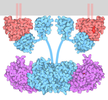

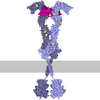

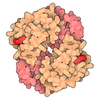


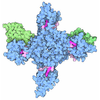
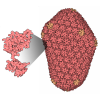


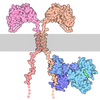
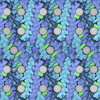
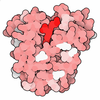

 Z (Sec.)
Z (Sec.) Y (Row.)
Y (Row.) X (Col.)
X (Col.)





















































